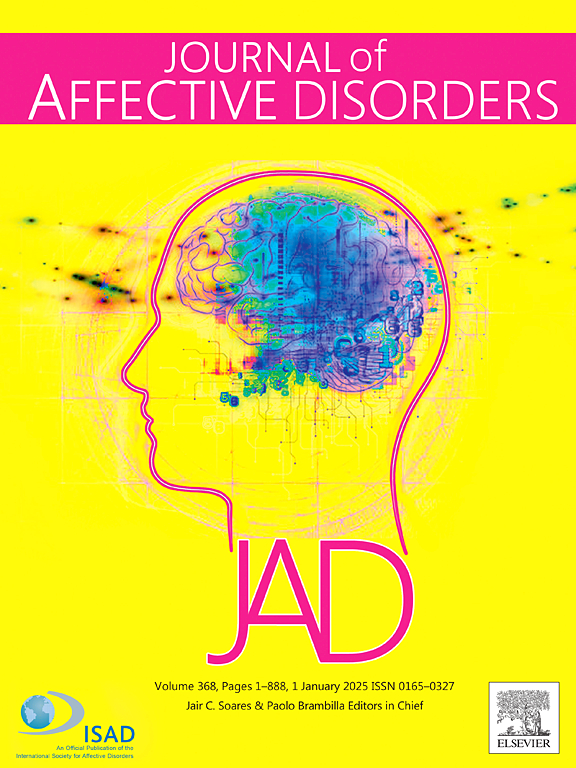Timing of physical activity, genetic predisposition, and incident depression: An accelerometer-based prospective cohort study
IF 4.9
2区 医学
Q1 CLINICAL NEUROLOGY
引用次数: 0
Abstract
Background
There is a lack of prospective cohort studies exploring the associations between the timing of physical activity and incident depression. This study aimed to explore the associations and to investigate whether genetic predisposition of depression may modify the associations.
Methods
The study using data from UK Biobank, included 76,218 participants. The data of total physical activity (TPA) and moderate-to-vigorous physical activity (MVPA) were collected by accelerometer measurements over 7 consecutive days. Cox proportional hazard models were performed to calculate the hazard ratio (HR) and 95 % confidence interval (CI).
Results
In total, compared to the midday-afternoon group, participants in the early morning group of TPA had a lower risk of depression (HR: 0.76, 95 % CI: 0.65–0.89). Compared to the inactive group, a lower risk of incident depression was found among the participants with MVPA in the morning (HR: 0.80, 95 % CI: 0.67–0.96) and middy-afternoon (HR: 0.82, 95 % CI: 0.70–0.96). The joint effect analysis of the timing of TPA and genetic predisposition for incident depression showed that compared to the participants with a high genetic predisposition and in the middy-afternoon group of TPA, early morning group had a reduced risk of depression regardless of genetic predisposition. However, in subgroup analyses for genetic predisposition, only participants with a high genetic predisposition to depression benefited from TPA in the early morning.
Conclusions
TPA in the early morning and MVPA in the morning and middy-afternoon were significantly associated with a lower depression risk, especially for participants with a higher genetic predisposition of depression.
体育活动的时间、遗传易感性和事件抑郁症:一项基于加速计的前瞻性队列研究。
背景:目前缺乏前瞻性队列研究来探讨体育活动的时间与事件性抑郁之间的关系。本研究旨在探讨两者之间的关联,并探讨抑郁症的遗传易感性是否会改变两者之间的关联。方法:该研究使用英国生物银行的数据,包括76,218名参与者。通过加速度计连续7天测量总体力活动(TPA)和中高强度体力活动(MVPA)数据。采用Cox比例风险模型计算风险比(HR)和95% %置信区间(CI)。结果:总的来说,与中午下午组相比,TPA清晨组的参与者患抑郁症的风险较低(HR: 0.76, 95 % CI: 0.65-0.89)。与不运动组相比,MVPA参与者在上午(HR: 0.80, 95 % CI: 0.67-0.96)和下午(HR: 0.82, 95 % CI: 0.70-0.96)发生抑郁症的风险较低。TPA时间和遗传易感性对偶发性抑郁症的联合效应分析表明,与高遗传易感性的参与者和下午TPA组相比,无论遗传易感性如何,清晨组的抑郁风险都降低了。然而,在遗传易感性的亚组分析中,只有具有高抑郁遗传易感性的参与者受益于清晨的TPA。结论:清晨的TPA和上午和下午的MVPA与较低的抑郁风险显著相关,特别是对于具有较高抑郁遗传易感性的参与者。
本文章由计算机程序翻译,如有差异,请以英文原文为准。
求助全文
约1分钟内获得全文
求助全文
来源期刊

Journal of affective disorders
医学-精神病学
CiteScore
10.90
自引率
6.10%
发文量
1319
审稿时长
9.3 weeks
期刊介绍:
The Journal of Affective Disorders publishes papers concerned with affective disorders in the widest sense: depression, mania, mood spectrum, emotions and personality, anxiety and stress. It is interdisciplinary and aims to bring together different approaches for a diverse readership. Top quality papers will be accepted dealing with any aspect of affective disorders, including neuroimaging, cognitive neurosciences, genetics, molecular biology, experimental and clinical neurosciences, pharmacology, neuroimmunoendocrinology, intervention and treatment trials.
 求助内容:
求助内容: 应助结果提醒方式:
应助结果提醒方式:


